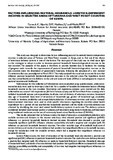| dc.description.abstract | This study was designed to determine factors influencing pastoral household livestock-dependent incomes in selected areas of Turkana and West Pokot counties in Kenya, and to find out if the choice of veterinary delivery systems is one of the factors. The main goal of the study was to shed more light on the strategies to adopt in order to increase pastoral household livestock-dependent incomes in the two counties. The purpose of this paper, is therefore, to provide baseline data to facilitate the tracking of progress made towards the improvement of pastoral household livestock-dependent incomes in the two counties since the devolution of government functions, following the adoption of a new national Constitution that was promulgated in March 2013. The study analyzed the social and economic factors that influence pastoral household livestock-dependent incomes in the selected areas. The hypothesis tested was that animal health service delivery in the arid and semi-arid lands (ASALs) is not adequate to improve pastoral incomes and livelihoods Field surveys for the collection of information were conducted using questionnaires, while socioeconomic data were used to draw up a ‘check list’ for a number of variables to determine factors affecting household income in the two counties. Descriptive and regression analyses were carried out for data collected from a total of 160 respondents (80 from Turkana county and 80 from West Pokot county), which included household income and expenditure, herd size, cost of delivery of veterinary services, household size, age of household head, level of education of household age, gender of household age, availability of credit to herders, availability and acceptability/satisfaction of veterinary services, and service demand. Semi-structured interviews were used to elicit specific information regarding the monthly animal health expenditure for a period of one year for the households involved and the mode of service delivery was obtained by identifying the most used animal health delivery systems in each area. The delivery systems considered included veterinarians (public or private), self-treatment using modern medicines, self-treatment using traditional medicines, or the use of community based animal health workers (CAHWs). The results indicated that in Turkana county, the level of education, acceptability/satisfaction with available services and distance to the nearest veterinary clinic showed positive and significant (p≤0.05) influences on pastoral household livestock derived incomes. Household size showed a positive and marginally significant (p≤0.10) influence whereas accessibility showed a negative and marginal (p≤0.10) influence on pastoral household livestock incomes. The other variables (age of household head, cost of service delivery, and mode of service delivery) had positive but insignificant effects on household incomes, except for satisfaction with the available services, which had a negative but insignificant influence on household income. In west Pokot county, the level of education of the household head also showed a positive and significant (p≤0.05) influence on pastoral household livestock incomes. The cost of service delivery showed a positive but marginal (p≤0.10) influence on pastoral household livestock incomes. Household size, age of household head, and mode of service delivery had positive but significant effects on household incomes whereas accessibility, availability, and acceptability of services had negative but insignificant influences on household incomes. From the results, it was concluded that the delivery of animal health services in the target areas at the time of the study, was neither effective nor sustainable and thus, it was not able to positively influence pastoral incomes and livelihoods. It is recommended that the government of Kenya, in collaboration with stakeholders in the livestock sub-sector takes measures to streamline research and extension on socioeconomic factors that affect livestock production and marketing and improve the delivery of animal health services in the two counties in order to significantly impact on pastoral household livestock derived incomes and livelihoods. It is further recommended that the Government and other stakeholders should explore an alternative animal health care delivery model for the Arid and Semi-Arid Lands (ASALs) other than CAHWs that is effective and acceptable within the current policy and legal frameworks. | en_US |

